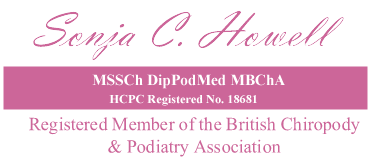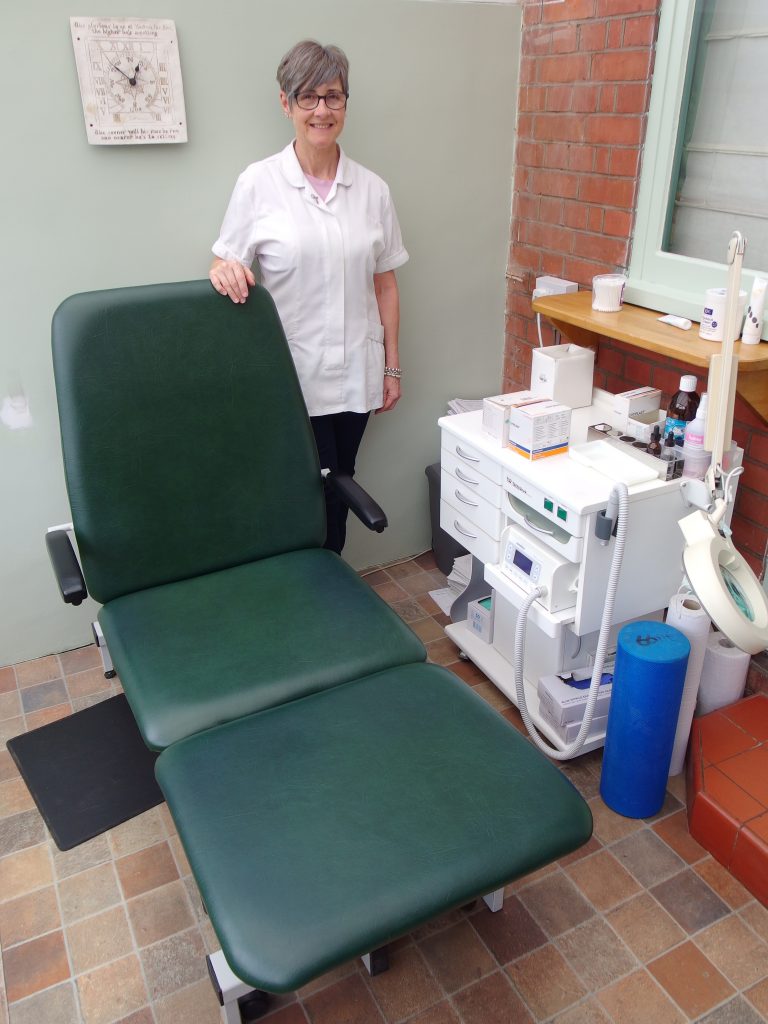

Based on a 45 minute appointment (approximately) I offer problem assessment, diagnosis and treatment that includes:
Trim and Rasp of Nails
General nail care and advice. Diagnosis of fungal infections of the nail and systemic conditions such as Eczema, Psoriasis, Lichen Planus.
Corn and Verrucae Treatment
Identifying correctly/offering treatment and advice for hard corns, soft corns, seed corns, and Verrucae Pedis in adults and children.
Verrucae pedis is the most common viral infection of the skin and is caused by the Human Papilloma Virus. The virus tends to thrive in damp conditions and is mainly transmitted in communal areas such as swimming pools, showers, gymnasia and hotel room floors through direct contact with the skin.
The virus is contagious and gains entry to the body through micro-injuries to the skin. This can easily take place through barefoot activities, especially when the skin has been wet for some time as in swimming or due to sweating after intense exercise followed by showering.
Hard Skin Treatments
Paring hard skin, dry skin and heel fissures from problem areas of the foot such as the heel, ball of foot and toes.
Ingrown, Thickened, Mis-Shapen Nails
A toenail is ingrown when one or both sides of the nail begin to break through and grow into the soft skin of the toe. This can lead to irritation and infection because of all the bacteria that hang out in and around feet.
Ingrown toenails can develop pretty quickly. The most common reason for ingrown toenails is cutting toenails too short. When people cut their nails too short, the skin on the sides can cover the corners of the nail. This causes the nail to grow back into the skin.
Thickened or mis-shapen nails can be acquired due to a hobby, sport or profession and/or congenitally acquired from birth or arise due to neglect.
Athletes Foot (Tinea Pedis)
Athlete’s foot, known medically as tinea pedis, is a common skin infection of the feet caused by fungus. Signs and symptoms often include itching, scaling, and redness. In severe cases the skin may blister. Athlete’s foot fungus may infect any part of the foot, but most often grows between the toes. The next most common area is the bottom of the foot. The same fungus may also affect the nails or hand. It is a member of the group of diseases known as tinea.
Bunion Care and Advice
A deviated joint whereby the big toe leans towards the second toe and the metatarsal bone protrudes towards the midline is referred to as a bunion.
Diabetic Feet
Diabetes is a disease in which the body is unable to properly use and store glucose (a form of sugar). In Type 1 (fomerly called juvenile-onset or insulin-dependent) diabetes, the body completely stops producing any insulin, a hormone that enables the body to use glucose found in foods for energy.
Type 2 diabetes happens when your body can’t use insulin the right way or when the pancreas can’t make enough insulin. Insulin is a hormone that helps the body’s cells use sugar (glucose) for energy. It also helps the body store extra sugar in muscle, fat, and liver cells.
People with diabetes are strongly urged to visit a chiropodist/podiatrist at least once a year.
Exercise and Padding
Advice offered to assist the range of movement of the joints and ligaments within the foot and help tone muscles. Padding used to deflect pain from pressure points on the foot and assist mobility.
Lower Limb Massage
Lower limb massage encourages new blood flow to the area of the lower limb and feet, encourages reduction of water retention and soothes aching, tired feet.
Biomechanical/Gait Analysis and Orthotics
Many things can cause a weak/poor gait, however, think of abnormal function as the joints being in the wrong position during walking or running and, therefore, being malaligned. Malalignments can be congenital (things you are born with), like knock knees which forces the foot into a flat position, or the problem may be due to a muscle imbalance. For example; tight hamstrings often cause knee pain and a short stride length, or a whole list of other things:
People can develop problems after surgery because the procedure has changed the shape of the foot.
Problems can also be due to poor posture.
Repeating an activity several times each day in the wrong position (repetitive strain) may cause muscle or joint pain-sports injuries e.g. sprains and strains, etc.
A Comprehensive Range of Foot Creams and Medications
Advice on those creams and medications that best suit common foot conditions such as the hot, moist, aching foot/leg or the dry, scaly, fissured foot/leg.
Heel Pain/Plantar Fasciitis/Plantar Fasciosis
Determining the cause and duration of heel pain and diagnosing the cause and possible treatment plan.
